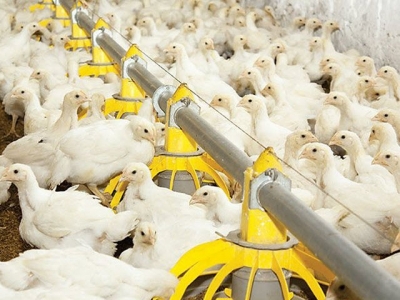How Much DDGS Can be Incorporated in a Layer Feed?

Research reviewed by Dr Kristjan Bregendahl, nutritionist for Hy-Line International, indicates that corn distillers dried grains with solubles (DDGS) can be included at high levels in diets for layers. Because of variability from different sources, he recommends implementing a strict quality assurance programme in purchasing DDGS as well as formulating diets containing more than 5 or 10 per cent of DDGS on the basis of digestible amino acids.
Corn distiller's dried grains with solubles (DDGS) is a co-product from fuel-ethanol production and contains all the nutrients found in corn grain, except most of the starch, which has been fermented to ethanol and carbon dioxide.
Corn DDGS contains approximately 27 per cent protein, 10 per cent oil, 0.48 per cent available phosphorus, and 2,850 kcal/kg (11.9 MJ/kg) nitrogen-corrected true metabolizable energy (TMEn). Although corn DDGS has a relatively high fibre content, corn DDGS can be included in layer diets as a source of energy and nutrients. The fibre added to the diet through corn DDGS may have beneficial effects on the hens' intestinal health and has been shown to reduce ammonia emission from layer manure.
When the benefits of corn DDGS on intestinal health and ammonia emission are ignored and only its contents of energy and nutrients are considered, the relative price of corn DDGS and other protein-, phosphorus- and energy-supplying ingredients determines how much corn DDGS is included in the hens' diet. When corn DDGS is used in US pullet and layer diets, it is typically included between 6 and 15 per cent of the diet. However, the increased price of all feed ingredients and a potentially reduction in corn grain availability may make higher corn DDGS inclusion rates more attractive. The question then becomes how much corn DDGS can be fed to layers without adversely affecting performance. This question was sought answered in two different experiments, presented at the Poultry Science Association annual meeting held in Ontario, Canada, in July 2008.
In one experiment, conducted at University of Nebraska-Lincoln by Masa'deh et al. (2008), white Leghorn-type laying hens were fed diets containing either 0, 5, 10, 15, 20 or 25 per cent corn DDGS from 24 to 36 weeks of age. There were no effects of corn DDGS addition on the hens' feed consumption rate, egg production or interior egg quality, although egg weight decreased with increasing corn DDGS content. This decrease was attributed an amino acid deficiency in the high-DDGS diets.
In another experiment, conducted at Iowa State University by Roberts et al. (2008), Hy-Line W-36 hens were fed diets containing 0, 23, 46 or 69 per cent corn DDGS for 8 weeks (from 53 to 61 weeks of age). These high corn DDGS inclusion levels were achieved through a step-up programme, where the corn DDGS was increased incrementally over a four-week period. In this experiment, egg production decreased with increasing dietary corn DDGS content but was off-set by an increase in egg weight such that egg mass was unaffected. The only observed effect on egg quality was an increase in egg yolk yellow colour. The increased egg weight was attributed an increase in the amount of dietary oil (including linoleic acid).
Results of the two experiments suggest that corn DDGS can be fed to laying hens at very high inclusion levels with only small effects on performance. However, the authors of both experiments noted that the flowability of the high-DDGS diets were reduced, such that the upper practical limit to feeding corn DDGS probably is around 15 to 20 per cent of the diet.
The nutrient content of corn DDGS from different ethanol manufacturing plants can vary substantially. It is therefore recommended that a strict quality assurance programme be implemented when purchasing corn DDGS or else limit the inclusion level to no more than 5 to 10 per cent of the diet. Preferably, minimum contents of crude protein (27 per cent), total fat (9 per cent), and total phosphorus (0.55 per cent), as well as maximum contents of acid detergent fibre (12 per cent) and neutral detergent fibre (40 per cent) should be guaranteed by the supplier. To avoid purchasing heat-damaged corn DDGS (with substantially lower amino acid digestibilities), the total lysine content should be at least 2.80 per cent of the crude protein content; amino acid digestibility assay kits are also available with which protein quality can be ascertained.
Finally, because the amino acid digestibility of corn DDGS are lower than those in corn grain, diets containing more than 5 to 10 per cent corn DDGS should be formulated on a digestible amino acid basis.
Related news
 To feed or not to feed? The importance of early chick feeding
To feed or not to feed? The importance of early chick feeding Dr Keith Bramwell, senior technical advisor to the Jamesway Incubator Company, addresses whether feeding individual chicks immediately after hatch is beneficial
 Research focuses on gait problems in broilers
Research focuses on gait problems in broilers Aarhus researchers among first to focus on causes and effects of impaired walking ability in conventional broilers where lameness is ruled out.
 12 ways to eliminate odour on poultry farms
12 ways to eliminate odour on poultry farms Statutory authorities have a duty to deal with odour complaints from a variety of sources, including poultry farming.